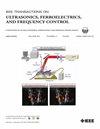Impact of In-Plane Diffraction in Temperature Compensated Surface Acoustic Wave Resonator on SiO2/131°YX-LiNbO3 Structure
IF 3.7
2区 工程技术
Q1 ACOUSTICS
IEEE transactions on ultrasonics, ferroelectrics, and frequency control
Pub Date : 2025-03-02
DOI:10.1109/TUFFC.2025.3566466
引用次数: 0
Abstract
This article investigates impact of in-plane surface acoustic wave (SAW) diffraction on the Bode Q curve in temperature compensated (TC) SAW resonators on 131°YX-LiNbO3 (131-LN). The right figure compares measured TC-SAW resonator characteristics with theoretical ones obtained by the periodic and full 3-D finite element method (FEM). Estimated ohmic resistance is subtracted from the measured result. The result of full 3-D FEM agrees very well with the experiment even Bode Q although no additional loss is included in the simulation. Full 3-D FEM can explain Bode Q variation with the number of IDT finger pairs (温度补偿表面声波谐振器面内衍射对SiO2/131°YX-LiNbO3结构的影响
本文研究了131oYX-LiNbO3表面声表面波(SAW)衍射对温度补偿(TC)声表面波谐振器波德Q曲线的影响。右图将TCSAW谐振腔的实测特性与周期有限元法和全三维有限元法(FEM)得到的理论特性进行了比较。从测量结果中减去估计的欧姆电阻。在不考虑附加损失的情况下,全三维有限元计算结果与实验结果吻合较好。全三维有限元法可以很好地解释波德Q随IDT指对数(NI)和孔径长度(W)的变化。这意味着面内SAW衍射是TC SAW器件的主要损耗机制之一。其次,将活塞模态设计应用于TC SAW结构以消除横向模态共振,并对宽W和NI范围进行全三维有限元模拟。结果表明,面内SAW衍射对TC-SAW谐振腔的波德Q有明显的降低,其影响比I.H.P. SAW更为严重。也就是说,TC SAW谐振器的波德Q比I.H.P. SAW谐振器对f、W和NI更敏感,这是由于表面的凹凸SAW慢度形状。
本文章由计算机程序翻译,如有差异,请以英文原文为准。
求助全文
约1分钟内获得全文
求助全文
来源期刊
CiteScore
7.70
自引率
16.70%
发文量
583
审稿时长
4.5 months
期刊介绍:
IEEE Transactions on Ultrasonics, Ferroelectrics and Frequency Control includes the theory, technology, materials, and applications relating to: (1) the generation, transmission, and detection of ultrasonic waves and related phenomena; (2) medical ultrasound, including hyperthermia, bioeffects, tissue characterization and imaging; (3) ferroelectric, piezoelectric, and piezomagnetic materials, including crystals, polycrystalline solids, films, polymers, and composites; (4) frequency control, timing and time distribution, including crystal oscillators and other means of classical frequency control, and atomic, molecular and laser frequency control standards. Areas of interest range from fundamental studies to the design and/or applications of devices and systems.

 求助内容:
求助内容: 应助结果提醒方式:
应助结果提醒方式:


